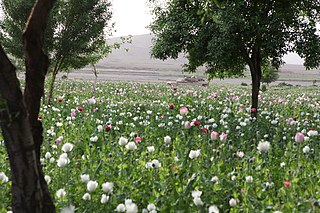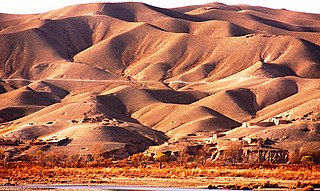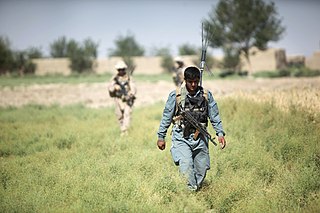Related Research Articles

Helmand, also known as Hillmand, in ancient times, as Hermand and Hethumand, is one of the 34 provinces of Afghanistan, in the south of the country. It is the largest province by area, covering 58,584 square kilometres (20,000 sq mi) area. The province contains 18 districts, encompassing over 1,000 villages, and roughly 1,446,230 settled people. Lashkargah serves as the provincial capital. Helmand was part of the Greater Kandahar region until made into a separate province by the Afghan government in the 20th century.

Abdul Rasul Sayyaf is an exiled Afghan politician and former mujahideen commander. He took part in the war against the Marxist–Leninist People's Democratic Party of Afghanistan (PDPA) government in the 1980s, leading the Afghan mujahideen faction Ittehad-al-Islami.

Atta Muhammad Nur is an Afghan exiled politician and former Mujahid Leader who served as the Governor of Balkh Province in Afghanistan from 2004 to January 25, 2018. An ethnic Tajik, he worked to educate the Mujahideen after the 1979 Soviet invasion of Afghanistan, gaining the nickname "The Teacher". He then became a mujahideen resistance commander for the Jamiat-e Islami against the Soviets.
Nassim also transliterated as Nacim, Naseem, Nasseem, Nasim, Nesim or Nessim, is a unisex name meaning "gentle breeze, fresh air". It is mostly used in Middle Eastern and South Asian cultures and language groups. It may refer to:

Arghandab is a district in the central part of Kandahar Province, Afghanistan. It borders Panjwai and Khakrez districts to the west, Shah Wali Kot District to the north and east and Kandahar District to the east and south.

Afghanistan has long had a history of opium poppy cultivation and harvest. As of 2021, Afghanistan's harvest produces more than 90% of illicit heroin globally, and more than 95% of the European supply. More land is used for opium in Afghanistan than is used for coca cultivation in Latin America. The country has been the world's leading illicit drug producer since 2001. In 2007, 93% of the non-pharmaceutical-grade opiates on the world market originated in Afghanistan. By 2019 Afghanistan still produced about 84% of the world market. This amounts to an export value of about US $4 billion, with a quarter being earned by opium farmers and the rest going to district officials, insurgents, warlords, and drug traffickers. In the seven years (1994–2000) prior to a Taliban opium ban, the Afghan farmers' share of gross income from opium was divided among 200,000 families.

Dadullah was the Taliban's most senior military commander in Afghanistan until his death in 2007. He was also known as Maulavi or Mullah Dadullah Akhund. He also earned the nickname of Lang, meaning "lame", because of a leg he lost during fighting.
Sher Mohammed Akhundzada is an Alizai tribal leader who was the Governor of Helmand in Afghanistan from 2001 to 2005. As governor, he implemented various agricultural projects in Helmand, including canal excavation from the Kajaki dam for irrigation and electricity generation projects. He was deeply involved in opium production and smuggling, leading to his removal from office by the Afghan government in 2005 after lobbying by the British, who were leading counter-narcotic efforts in Afghanistan at the time. He was succeeded as governor of Helmand by Mohammad Daoud.
Mohammad Daoud was the governor of Helmand in Afghanistan until he was removed from his post for his ties to the opium trade. Daoud was appointed in December 2005, and replaced in December 2006 after the insistence of the British ISAF troops. The U.S. used the warlords to help them hunt Al Qaeda and the Taliban and it is rumored this extended to ignoring their involvement in the production and sale of opium.

Musa Qala is a district in the north of Helmand Province, Afghanistan. Its population was around 57,500 in 2012 and are 97% ethnic Pashtun. The district centre is the village of Musa Qala; there are 19 other large villages and 200 smaller settlements, mostly along the Musa Qala River. The area is irrigated by the Helmand and Arghandab Valley Authority.

Nāwa-I-Barakzāyi District is an administrative district in Helmand Province, Afghanistan located south of the provincial capital of Lashkar Gah along the Helmand River. It is bordered by the districts of Lashkar Gah, Nad Ali, Garmsir, and Rig, as well as the provinces of Nimruz and Kandahar. It falls within the area known as Pashtunistan,, an area comprising most of southeast Afghanistan and northwest Pakistan. The dominant language is Pashto and many of the 89,000 residents practice the traditional code of Pashtunwali. Nawa-I-Barakzayi's name reflects the dominant Pashtun tribe in the district, the Barakzai. Prior to the 1970s, it was called Shamalan after a small village at the south end of the district

Garmsir District is located in the southern part of Helmand Province, Afghanistan. The district is large, but all the villages are along the Helmand River. The rest is a desert. The district capital, Garmsir, is located in the northwestern part of the district on the east bank of Helmand River.

Amir Muhammad Akhundzada is an Afghan politician, He is a former governor of Nimruz province. He was previously the governor of Oruzgan province. Prior to that he served as Deputy Governor of Helmand province.

The Helmand province campaign was a series of military operations conducted by the International Security Assistance Force (ISAF) forces against Taliban insurgents and other local groups in the Helmand Province of Afghanistan. Their objective was to control a province that was known to be a Taliban stronghold, and a center of opium production. None of the ISAF's intended strategic and political objectives were achieved in the long term.
Mullah Abdul Salaam Alizai is a former member of the Taliban movement who defected to the Afghan government in December 2007. He is a leader of the Alizai, a Pashtun tribe.
Mohammad Nasim Faqiri is an Afghan politician and diplomat. He has served as a longtime spokesman for Jamiat-e Islami in Afghanistan, and was appointed Secretary General of the organization.

Mullah Hibatullah Akhundzada, also spelled Haibatullah Akhunzada, is an Afghan Deobandi Islamic scholar, cleric, and jurist who is the supreme leader of Afghanistan. He has led the Taliban since 2016, and came to power with its victory over U.S.-backed forces in the 2001–2021 war. A highly reclusive figure, he has almost no digital footprint except for an unverified photograph and several audio recordings of speeches.

Peace processes have taken place during several phases of the Afghanistan conflict, which has lasted since the 1978 Saur Revolution.
Akhundzada is a surname. Notable people with the name include:
The 2006 Taliban offensive was a major military offensive launched by the Taliban in southern Afghanistan in the spring of 2006. The offensive was planned to unfold on three main fronts concentrated in the provinces of Helmand and Kandahar: the first front was to target northern Helmand, focusing on the districts of Sangin, Nowzad, and Kajaki. The second front aimed at southern Helmand, with a focus on the districts of Garmser and Nawa. The third, and most important, would be western Kandahar, targeting the districts of Maiwand, Zharey, and Panjwayi.
References
- ↑ Malkasian, Carter (2013). War Comes to Garmser: Thirty Years of Conflict on the Afghan Frontier. Oxford University Press. p. 21. ISBN 978-0-19-997375-0.
- ↑ Giustozzi, Antonio. "TRIBES" AND WARLORDS IN SOUTHERN AFGHANISTAN, 1980-2005" (PDF). Archived from the original (PDF) on 2007-10-16.
- ↑ Malkasian 2013, p. 46.